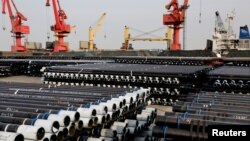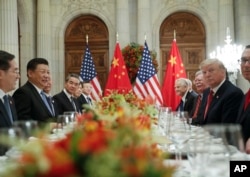China’s export growth slowed in November as global demand weakened, adding to pressure on Beijing ahead of trade talks with Washington.
Exports rose 5.4 percent from a year ago to $227.4 billion, a marked decline from the previous month’s 12.6 percent increase, customs data showed Saturday. Imports rose 3 percent to $182.7 billion, a sharp reversal from October’s 20.3 percent surge.
That adds to signs a slowdown in the world’s second-largest economy is deepening as Chinese leaders prepare for negotiations with President Donald Trump over Beijing’s technology policy and other irritants.
Exports to US rise
Chinese exports to the United States rose by a relatively robust 12.9 percent from a year ago to $46.2 billion. Shipments to the U.S. market have held up as exporters rush to fill orders before additional duty increases, but forecasters say that effect will fade in early 2019.
Imports of American goods rose 5 percent to $10.7 billion, down from the previous month’s 8.5 percent growth. China’s politically volatile trade surplus with the United States widened to a record $35.5 billion.
Trump agreed during a Dec. 1 meeting with this Chinese counterpart, Xi Jinping, to postpone tariff hikes by 90 days while the two sides negotiate. But penalties of up to 25 percent imposed earlier by both sides on billions of dollars of each other’s goods still are in effect.
Companies and investors worry the battle between the two biggest economies will chill global economic growth.
Chinese economy cools
The Chinese economy grew by a relatively strong 6.5 percent from a year earlier in the quarter ending in September. But that was boosted by government spending on public works construction that helped to mask a slowdown in other parts of the economy.
An official measure of manufacturing activity fell to its lowest level in two years in November. Auto sales have shrunk for the past three months, and real estate sales are weak.
Chinese leaders have responded by easing lending controls, boosting spending on construction and promising more help to entrepreneurs who generate the state-dominated economy’s new jobs and wealth. But they have moved gradually to avoid reigniting a rise in corporate and local government debt that already is considered to be dangerously high.
Tariffs
The Trump administration imposed 25 percent duties on $50 billion of Chinese goods in July in response to complaints that Beijing steals or pressures companies to hand over technology. Washington also imposed a 10 percent charge on $200 billion of Chinese goods. That was set to rise to 25 percent in January but Trump postponed it.
Beijing responded with tariff hikes on $110 billion of American goods. Trump has threatened to expand U.S. penalties to all goods from China.
Washington, Europe and other trading partners complain plans such as “Made in China 2025,” which calls for creating Chinese global champions in artificial intelligence, robotics and other fields, violate Beijing’s market-opening obligations.
Trump said Beijing committed to buy American farm goods and cut auto import tariffs as part of the tariff cease-fire. Chinese officials have yet to confirm details of the agreement.
China’s Commerce Ministry expressed confidence the two sides can reach a deal during the 90-day delay. That indicates Beijing sees resolving the conflict as too important to allow it to be disrupted by last week’s dramatic arrest in Canada of an executive of Huawei Technologies Ltd., one of China’s most prominent companies, on accusations of violating trade sanctions on Iran.
Big trade disputes
Private sector analysts say that there is little time to resolve sprawling conflicts that have bedeviled U.S.-Chinese trade for years. That suggests Beijing will need to find ways to persuade Trump to extend his deadline.
Also in November, China’s exports to the 28-nation European Union rose 11.4 percent over a year earlier to $35.9 billion, down from October’s 12 percent growth. Imports rose 13.2 percent to $24.4 billion.
China’s trade surplus with the EU widened by 6.4 percent over a year earlier to $11.5 billion.










